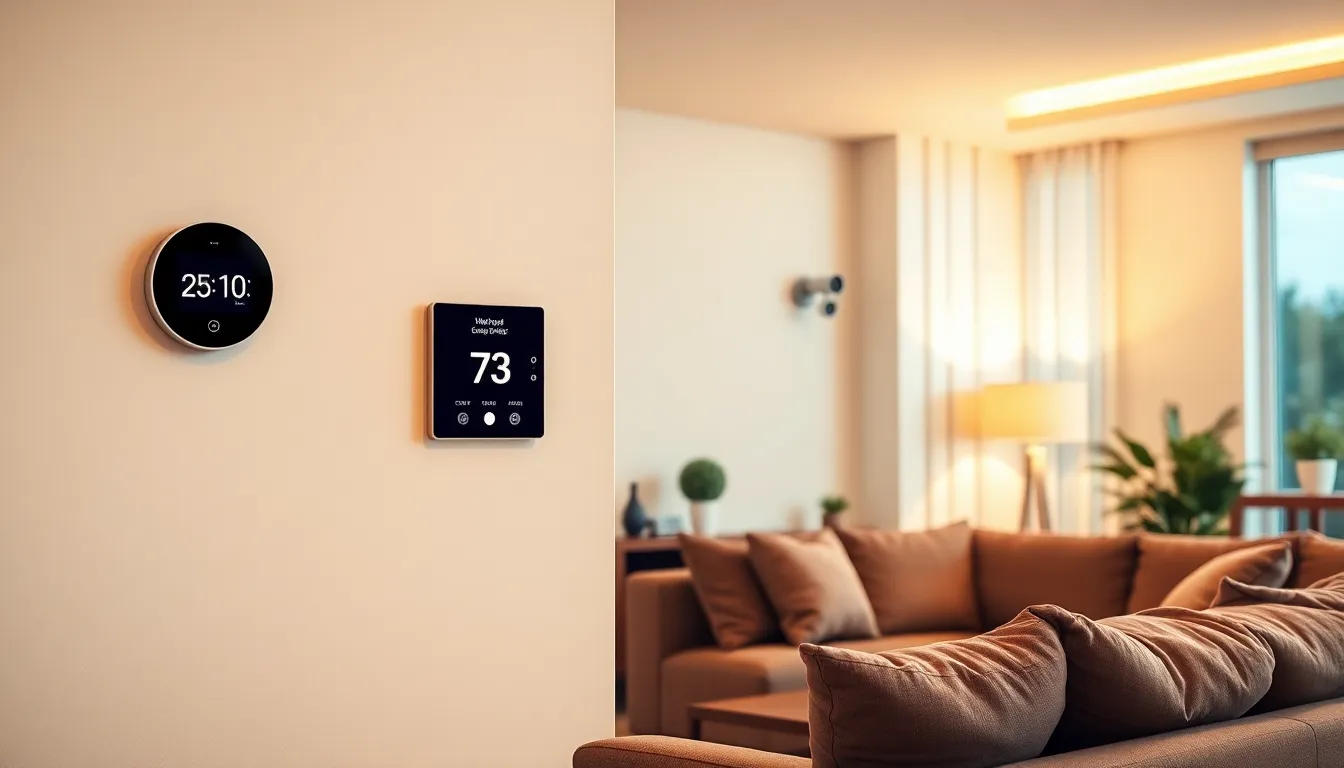Table of Contents
ToggleImagine a home that not only knows your favorite temperature but also reminds you when to water your plants—yes, that’s right! Smart homes are revolutionizing the way people live, blending convenience with a touch of futuristic flair. With technology at their fingertips, homeowners can control everything from lighting to security systems with just a few taps on their smartphones.
Understanding Smart Homes
Smart homes integrate advanced technology to enhance convenience and efficiency. Homeowners can control various systems, from security to lighting, using their smartphones or voice commands.
What Defines a Smart Home?
A smart home features interconnected devices that communicate with each other for seamless operation. Devices such as smart thermostats, smart doorbells, and smart lights exemplify this connectivity. Homeowners can monitor and control these devices remotely, enhancing security and comfort. Compatibility with platforms like Amazon Alexa or Google Assistant further defines a smart home, allowing users to integrate multiple gadgets for a cohesive experience.
Key Features of Smart Homes
Smart homes offer key features that significantly improve daily living. Automated temperature control maintains comfort by adjusting based on occupancy. Smart lighting enables remote management and customizable schedules for energy savings. Security systems provide real-time alerts and remote access, ensuring safety. Additionally, smart appliances, like refrigerators and ovens, streamline household tasks, improving overall efficiency. By incorporating these features, smart homes promote a modern lifestyle that prioritizes convenience and security.
Benefits of Owning a Smart Home

Smart homes provide numerous advantages, significantly enhancing the quality of life for homeowners.
Energy Efficiency
Smart homes ensure energy efficiency through automated systems, including smart thermostats and lighting. These devices adjust energy usage based on occupancy and preferences, reducing utility bills by up to 30%. Homeowners can schedule heating and cooling according to their routines, minimizing wastage. Smart power strips deactivate unused electronics, further decreasing energy costs. Additionally, energy-monitoring systems offer real-time insights, allowing homeowners to track consumption patterns. Overall, smart technology contributes to a greener environment while optimizing energy use.
Enhanced Security
Smart homes feature advanced security measures that significantly enhance safety. Security cameras with real-time alerts inform homeowners of unusual activity. Doorbell cameras enable two-way communication, allowing residents to interact with visitors remotely. Automated lighting systems deter potential intruders by simulating occupancy. Smart locks provide remote access control, enabling secure entry options without traditional keys. Integrating these systems allows homeowners to monitor their property from anywhere, ensuring peace of mind at all times. Enhanced security features make smart homes a popular choice for those prioritizing safety and convenience.
Popular Smart Home Devices
Smart home devices enhance convenience, safety, and efficiency in modern living spaces. Homeowners increasingly rely on these devices for better control and automation of their homes.
Smart Lighting Solutions
Smart lighting solutions offer customizable control over home illumination. Homeowners can adjust brightness levels and colors through smartphone apps or voice commands. Popular products include smart bulbs from brands like Philips Hue and LIFX, which integrate with various smart home ecosystems. Energy-efficient LED technology reduces electricity bills, and automation features allow for scheduling lights to turn on or off at specific times. These solutions enhance security by simulating occupancy while homeowners are away, acting as an effective deterrent against intruders.
Home Automation Systems
Home automation systems simplify managing multiple devices within a smart home. Platforms like Amazon Alexa, Google Home, and Apple HomeKit centralize control, allowing homeowners to operate devices through a single interface. Smart thermostats, like Nest and Ecobee, offer optimal heating and cooling schedules, significantly improving energy efficiency. Integrated systems also enable routines, where multiple devices act synchronously, such as turning off lights and locking doors at bedtime. These systems enhance daily routines, adding convenience and peace of mind to homeowners.
Market Trends for Smart Homes for Sale
In recent years, the demand for smart homes has surged, reflecting a shift in consumer preferences towards technology-driven living spaces.
Current Real Estate Trends
Smart homes account for an increasing percentage of new residential properties on the market. Reports indicate that around 30% of home buyers prioritize smart technology features when purchasing. Popular features include smart lighting, energy-efficient appliances, and security systems. Developers are responding by integrating these technologies into their designs, with 72% of builders reporting an increase in smart home installations. Moreover, homes offering smart technology typically see higher resale values, often commanding a price premium of 5-10% compared to traditional homes.
Predictions for the Future
The smart home market is projected to grow by 25% annually over the next five years. Experts predict that advancements in AI and IoT will enhance the interconnectivity of devices, enabling even more integrated solutions. Homeowners will increasingly seek personalized systems tailored to their specific needs. By 2028, nearly 70% of homes may feature smart technology, transforming them into fully automated ecosystems. Additionally, the integration of renewable energy sources in smart homes is expected to boost energy efficiency and sustainability, appealing to environmentally-conscious buyers.
How to Choose the Right Smart Home
Choosing the right smart home involves evaluating several key factors to ensure it meets specific needs and preferences.
Factors to Consider
Evaluate energy efficiency, security, compatibility, and ease of use when selecting a smart home. Prioritize features like automated scheduling for energy management and intuitive interfaces for device control. Consider the integration of advanced security measures, such as video surveillance and alarm systems. Investigate the range of compatible smart devices, as this enhances the functionality of the home ecosystem. Assess the reputation of the smart home brand, as well-established manufacturers typically offer reliable support and updates.
Assessing Compatibility with Existing Technology
Determine compatibility between new smart home systems and existing devices. Check for integration with smart assistants such as Amazon Alexa, Google Assistant, or Apple HomeKit. Verify that new devices support commonly used protocols like Wi-Fi, Zigbee, or Z-Wave. Ensuring interconnectivity enhances convenience and functionality, allowing seamless communication among devices. Investigate manufacturers’ specifications for compatibility points to maximize operational efficiency across the technology stack. Prioritize options that offer flexibility for future upgrades or additional devices, maintaining adaptability in smart home functionality.
Smart homes represent a significant shift in how people interact with their living spaces. By integrating advanced technology with everyday tasks, they offer unparalleled convenience and security. As the demand for these innovative homes continues to rise, potential buyers are increasingly prioritizing smart features that enhance energy efficiency and safety.
Investing in a smart home not only improves daily living but also provides long-term value. With the market projected to grow rapidly, now’s the perfect time to explore available options. Homeowners can enjoy a lifestyle that seamlessly blends technology with comfort, ensuring their homes are both modern and efficient. Embracing smart home technology is more than a trend; it’s a step toward a smarter and more sustainable future.









